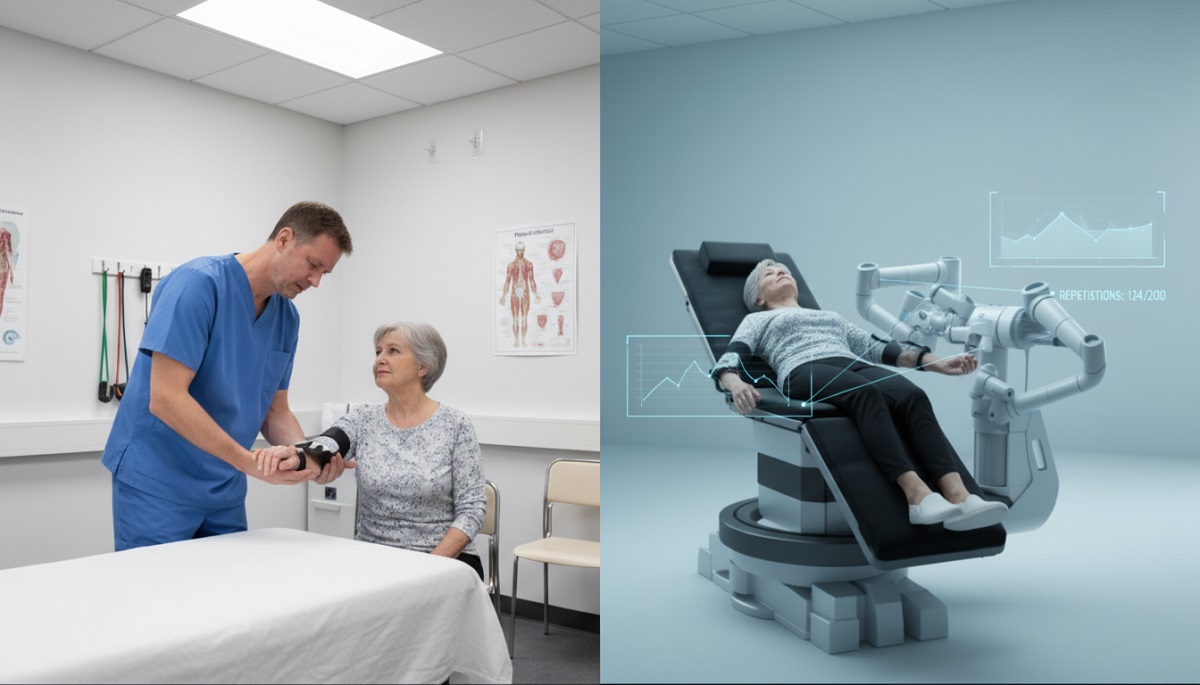
REVOLUTIONIZE Therapy: 7 Proven Ways Robotic Assisted Rehabilitation Outperforms Traditional Care
Introduction: A New Era in Rehabilitation
Robotic Assisted Rehabilitation is transforming the landscape of physical and cognitive rehabilitation, bringing precision, consistency, and scalability that traditional therapy alone cannot achieve.
In Europe, where more than 130 million people are aged 60+, the need for effective rehabilitation is critical. Yet, healthcare systems are struggling — with an estimated 4.1 million therapist shortages across the EU by 2030 (European Commission, 2023).
Traditional therapy, though invaluable, faces challenges of limited time, therapist fatigue, and inconsistent repetition, all of which can slow recovery.
Enter Robotic Assisted Rehabilitation, where intelligent devices like ErgoBot, powered by data and automation, deliver targeted, measurable, and efficient therapy — elevating care quality for every patient.

Precision and Consistency Beyond Human Capability
In traditional rehabilitation, manual repetition can vary session to session depending on fatigue, time pressure, or human error.
Robotic Assisted Occupational Therapy ensures exactly repeatable movement patterns, maintaining consistent force, speed, and range across hundreds of repetitions.
For example, devices like ErgoBot can record and replicate each motion with millimeter accuracy, ensuring precise rehabilitation outcomes — a level of standardization and data capture impossible by hand.
Increased Therapy Intensity and Duration
Studies show that successful motor recovery after stroke or orthopedic injury requires hundreds of repetitions per session, far more than typical manual sessions allow (PubMed, 2022).
With Robotic Assisted Rehabilitation, therapy sessions can run longer and more frequently without therapist fatigue — enhancing neuroplasticity and muscle re-education.
ErgoBot-powered therapy enables high-intensity rehabilitation across the full range of motion while freeing therapists to supervise multiple patients simultaneously, boosting productivity and access.
Empowering Therapists, Not Replacing Them
One of the greatest misconceptions is that robotics replace humans.
In reality, Robotic Assisted Occupational Therapy empowers therapists — allowing them to focus on evaluation, motivation, and complex treatment decisions while robots handle the repetitive, labor-intensive tasks.
This balance of human expertise and robotic precision helps mitigate therapist shortages and ensures that every patient receives consistent, evidence-based therapy — even in nursing home automation or Robotic Assisted Nursing Home environments.
Data-Driven Rehabilitation with Real-Time Feedback
Unlike traditional therapy that relies heavily on observation and subjective notes, Robotic Assisted Rehabilitation continuously collects quantitative performance data — joint angles, force, range of motion, and progression trends.
This data is invaluable for AI-assisted rehabilitation systems like PhysioEye, which analyze outcomes over time and predict recovery plateaus or potential complications.
Therapists can make evidence-based adjustments — ensuring personalized, adaptive care that evolves with every session.
Enhanced Safety and Motivation
Patient motivation and safety are central to recovery.
Robotic Assisted Rehabilitation integrates AI-powered safety systems, monitoring resistance and fatigue levels to prevent overexertion.
Gamified interfaces and visual progress tracking engage patients, turning rehabilitation into an interactive experience.
According to Frontiers in Rehabilitation Sciences, robotic therapy significantly increases adherence and emotional engagement — vital for long-term outcomes in geriatric and neurological rehabilitation.
Expanding Access Through TeleRehabilitation
Combining robotics with telephysiotherapy opens a new frontier in remote care.
Devices like ErgoBot and PhysioEye integrate seamlessly into AI-assisted tele-rehabilitation systems, allowing therapists to monitor, adjust, and guide therapy remotely.
This means patients in rural or under-resourced areas can receive the same high-quality robotic therapy as those in major centers — a major leap toward equitable healthcare.
The Foundation of the Robotic Assisted Nursing Home
The integration of Robotic Assisted Ergotherapy, Robotic Assisted Occupational Therapy, and Robotic Assisted Rehabilitation technologies is reshaping care facilities.
Systems like TrollyBot automate logistics, while SeniorFit maintains elderly fitness routines, and PhysioEye provides automated mobility and posture assessments — all connected through smart nursing home automation frameworks.
Together, they form the core of a Robotic Assisted Nursing Home, where care is continuous, data-driven, and seamlessly coordinated.
Conclusion: From Manual to Intelligent Rehabilitation
Traditional rehabilitation will always remain vital for human empathy and skilled guidance — but Robotic Assisted Occupational Therapy adds the intelligence, precision, and scalability modern care demands.
With devices like ErgoBot leading the transformation, robotic systems no longer support therapy — they define its future.
